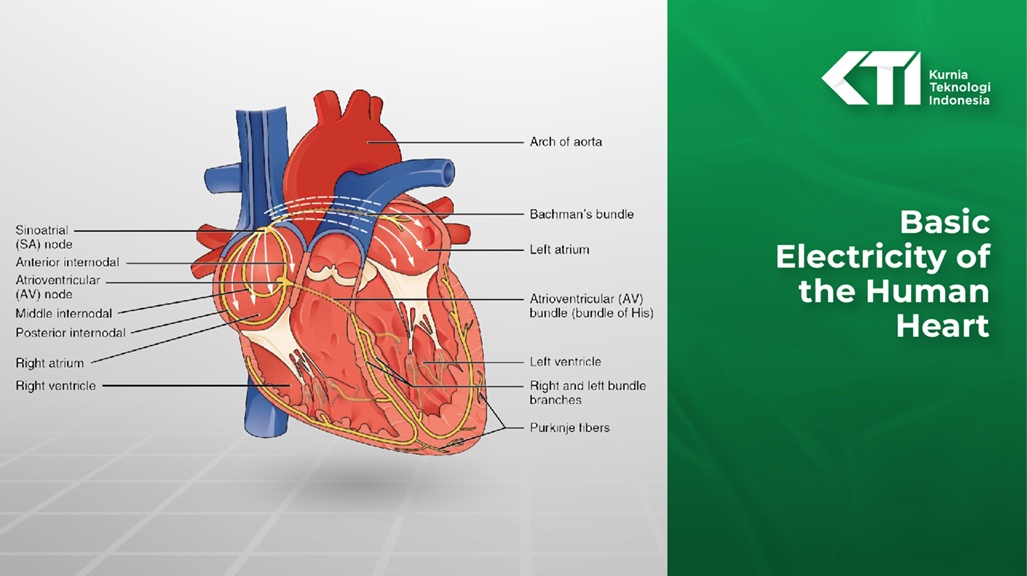Let's Learn Basic Electricity of the Human Heart
The human heart is a complex organ that is responsible for pumping blood throughout the body. One of the critical components of the heart's function is the generation of electrical impulses that control the timing and strength of the heart's contractions. The process of generating and conducting electrical signals in the heart is known as human cardiac electricity.
The heart is composed of four chambers: the right atrium, right ventricle, left atrium, and left ventricle. The electrical signals that control the heart's contractions begin in a specialized group of cells called the sinoatrial (SA) node, located in the right atrium. The SA node acts as the heart's natural pacemaker, sending electrical impulses that stimulate the atria to contract and pump blood into the ventricles.
From the SA node, the electrical signals travel through a pathway of specialized cells called the atrioventricular (AV) node. The AV node delays the transmission of the signal to allow the atria to fully contract before the ventricles begin to contract. After passing through the AV node, the electrical signals travel down specialized fibers called the bundle of His and then into the Purkinje fibers, which distribute the signal to the ventricular muscle cells.
Human Cardiac Electricity Overview
The overview of the pathways involved in human cardiac electricity:
- The sinoatrial (SA) node, located in the right atrium, generates electrical impulses that stimulate the atria to contract.
- The electrical signal travels through specialized pathways in the atria, causing the atrial muscles to contract and pump blood into the ventricles.
- The atrial-ventricular (AV) node serves as a gateway between the atria and ventricles, delaying the electrical signal to allow for the atria to contract fully before the ventricles are stimulated.
- From the AV node, the electrical signal passes through the bundle of His, a pathway of specialized fibers that divides into the left and right bundle branches.
- The left and right bundle branches then distribute the electrical signal to the Purkinje fibers, which are a network of specialized cells that spread the electrical impulse throughout the ventricles.
- The electrical signal causes the ventricular muscle cells to contract, pumping blood out of the heart and into the arteries.
- After the ventricles contract, the heart relaxes, and the electrical activity in the heart returns to its resting state.
- The entire process of electrical activity in the heart is coordinated by a system of specialized cells and pathways, ensuring that the heart pumps blood efficiently and effectively.
The timing and strength of the electrical signals generated in the heart are crucial for proper heart function. Abnormalities in the generation or conduction of electrical signals can result in various heart conditions, including arrhythmias, tachycardia and bradycardia.
In an electrocardiogram (ECG or EKG), electrodes placed on the skin detect the electrical signals generated by the heart. The ECG can be used to diagnose various heart conditions by examining the patterns of electrical activity recorded from different parts of the heart.
Various factors can influence the generation and conduction of electrical signals in the heart. For example, the sympathetic nervous system can increase heart rate and contractility by releasing the neurotransmitter norepinephrine, while the parasympathetic nervous system can slow heart rate and contractility by releasing the neurotransmitter acetylcholine.
Certain medications, such as beta-blockers and calcium channel blockers, can affect the generation and conduction of electrical signals in the heart. These medications are used to treat various heart conditions, including hypertension, angina, and arrhythmias.
Atrial fibrillation is a common arrhythmia that occurs when the atria contract rapidly and irregularly, leading to an inefficient pumping of blood into the ventricles. Atrial fibrillation can be caused by various factors, including age, hypertension, heart disease, and hyperthyroidism.
Ventricular fibrillation is a life-threatening arrhythmia that occurs when the ventricles contract rapidly and irregularly, preventing the heart from effectively pumping blood to the body. Ventricular fibrillation can be caused by various factors, including heart disease, electrolyte imbalances, and drug overdoses.
Cardioversion is a procedure that uses electrical shocks to reset the heart's electrical activity and restore normal heart rhythm. Cardioversion can be used to treat various arrhythmias, including atrial fibrillation and ventricular tachycardia.
Human cardiac electricity plays a crucial role in the proper function of the heart. The generation and conduction of electrical signals in the heart are affected by various factors, including the autonomic nervous system, medications, and various heart conditions. Understanding human cardiac electricity is essential for the diagnosis and treatment of various heart conditions, including arrhythmias and heart failure.

